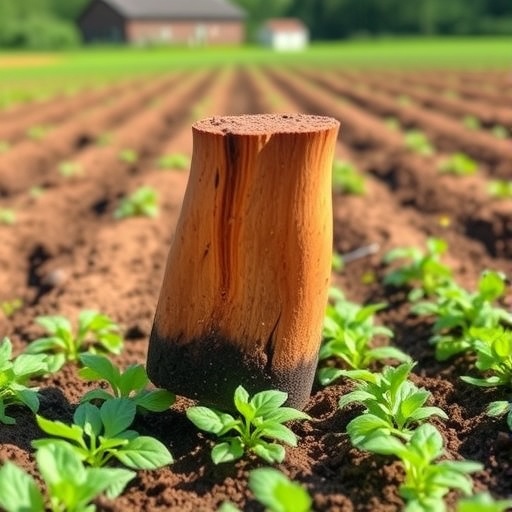Soil tillage practices have long been a cornerstone of agricultural productivity, influencing everything from crop yields to soil health. Recent research spearheaded by Ketena, Gebresenbet, and Kolhe has shed new light on the intricacies of soil tillage interactions, particularly focusing on workability and draft power efficiency. As farmers face increased pressures to optimize their operations, understanding the dynamics of these factors has become paramount for sustainable agricultural practices.
The study, published in the journal “Discover Agriculture,” embarks on a comprehensive investigation into how different tillage methods can either facilitate or hinder workability in soil preparation. The researchers highlighted that workability is crucial, especially during critical planting periods when timely operations can significantly impact crop establishment. The study illuminates the various soil conditions under which different tillage practices might impact this workability, offering insights that are both technically grounded and invaluable for agricultural practitioners.
Throughout the investigation, the authors looked closely at various tillage systems, such as conventional tillage, reduced tillage, and no-till practices. Each system offers a unique set of advantages and challenges, particularly when measured against the metrics of draft power efficiency and workability. For instance, conventional tillage may provide immediate benefits in terms of seedbed preparation but can require higher fuel consumption and labor input due to increased draft resistance.
The research also reviews the impact of soil moisture content, compaction levels, and residue management on the performance of tillage equipment. As it turns out, moisture levels can drastically alter the workability of soil. Wet conditions, while sometimes beneficial for soil structure, can lead to clumping and increased drag on tillage implements. Conversely, overly dry soil can become hard and resistant, making tillage operations more challenging and labor-intensive.
Another noteworthy aspect of the study involves the role of soil structure and texture in influencing tillage effectiveness. Soils classified by their textural properties—such as sandy, loamy, or clay-heavy mixtures—demonstrate varied responses to tillage methods. For example, sandy soils tend to respond favorably to reduced tillage practices due to their naturally loose structure. In contrast, clay soils can benefit from thorough tillage to break up compaction but require careful management to avoid overworking and damaging soil structure.
The significance of draft power efficiency cannot be overstated in the realm of agricultural operations. The researchers measured the power requirements for various tillage implements under different conditions, revealing that inefficiencies in draft power not only escalate operational costs but can also compound the environmental footprint of agricultural activities. Improving draft power efficiency through informed choices of tillage practices can yield substantial economic and ecological benefits.
Additionally, the study underscores the importance of integrating advanced technologies, such as precision agriculture tools, into traditional tillage practices. Utilizing data on soil health, moisture content, and plant growth can empower farmers to make informed decisions that optimize workability and draft efficiency. The incorporation of such technologies can also pave the way for more sustainable practices, further reducing the need for excessive tillage while maintaining productivity.
Throughout the research, the authors emphasize the need for adaptive management strategies tailored to specific farming contexts. The variability in soil types, local climate conditions, and crop requirements necessitates a flexible approach to tillage. Recognizing that a one-size-fits-all strategy is often ineffective, the researchers advocate for an evidence-based framework that combines empirical data with on-the-ground observations by farmers.
The ecological implications of soil tillage are also critically examined. Soil is a living organism, and disturbances from tillage can disrupt the complex networks of microorganisms that play a vital role in nutrient cycling. The research discusses how certain tillage practices can lead to degradation over time, while others may enhance soil organic matter content and promote healthier ecosystems.
As the agricultural sector pivots towards sustainability, this study serves as a vital resource for disseminating best practices that harmonize productivity with environmental stewardship. Through meticulous investigation and analysis, the authors have laid out a pathway for future research and policy-making that could lead the way to more sustainable agricultural systems.
In summary, the research conducted by Ketena, Gebresenbet, and Kolhe provides critical insights into the interactions of soil tillage systems and their impact on workability and draft power efficiency. As pressures mount on agricultural practices to be more efficient and sustainable, the findings emphasize the necessity of ongoing research and adaptation within farming communities. The commitment to optimizing tillage practices has the potential to enhance not only individual farm outputs but also contribute to broader ecological goals.
In conclusion, the findings from this study are not merely academic; they are fundamentally practical and carry significant implications for farmers around the world. By understanding and implementing the most efficient soil tillage practices, stakeholders can contribute to the dual goals of increased productivity and sustainability in agriculture. As the agricultural landscape continues to evolve, such research will play an essential role in shaping practices that are not only economically viable but also friendly to the environment.
Subject of Research: Soil tillage interactions, workability, draft power efficiency.
Article Title: Soil tillage interactions study based on workability and draft power efficiency.
Article References:
Ketena, S., Gebresenbet, G., Kolhe, K.P. et al. Soil tillage interactions study based on workability and draft power efficiency.
Discov Agric 3, 182 (2025). https://doi.org/10.1007/s44279-025-00350-0
Image Credits: AI Generated
DOI: 10.1007/s44279-025-00350-0
Keywords: Soil tillage, workability, draft power efficiency, sustainable agriculture, agricultural practices, soil structure, precision agriculture.
Tags: agricultural productivity insightsconventional vs reduced vs no-tillcritical planting periods in agriculturedraft power efficiency in tillageimpact of tillage on crop yieldsoptimizing farming operationsresearch on tillage systemssoil health and tillage interactionssoil tillage practicessustainable agricultural practicestillage methods comparisonworkability in soil preparation






